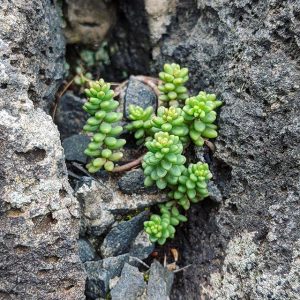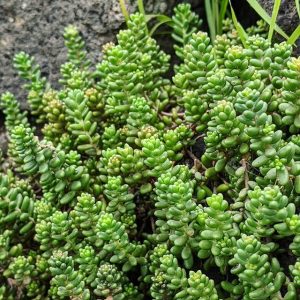White Stonecrop (Sedum album), a modest European succulent well-established in parts of coastal North America and a rare or perhaps just cryptic presence in southern Australia.
Available for purchase in Melbourne by 1864 (Handasyde, McMillan), White Stonecrop has long been a staple groundcover of rock gardens, and more recently has become a key drought-tolerant selection for green roofs around the world.
Recorded naturalised in New Zealand in the 1950s, in Australia the species has been collected in widely scattered positions since the 1990s: in the bushfire-ravaged St Michael’s Seminary ruins at Mount Lofty SA in 1996, a gravel alpine roadside at Thredbo NSW in 1997, a highway roadside at Pontville TAS in 2000, and a remote roadside at Orford here in Victoria in 2002.
Within the metropolitan, the White Stonecrop has been collected on the foreshore at Mount Eliza and recorded in surveys at Fawkner General Cemetery and at a golf course at Glenroy. However, its small stature and preference for rock exposures and other extreme or engineered environments means that the plant may be overlooked at other sites. From any distance beyond a metre or two, this sedum becomes effectively indistinguishable from common wall and pavement weeds like Allseed, and naturalised occurrences can often be quite small and scattered in area and effect.
The photographed plants form two distinctive and unrecorded colonies: on the engineered road bluffs of Yarra Boulevard in Yarra Bend Park, and on a wildly weed-diverse basalt exposure on the Darebin Creek in Ivanhoe. Both have probably originated in dumped or eroded garden waste; the Darebin Creek exposure clearly has a lost history as an absurd horticultural tip. The Yarra Boulevard colony is extensive and of apparent long standing, occupying both a section of dry bluestone retaining wall and areas of semi-consolidated earthen slope below.
View Original Post on Instagram
Search for information about Sedum album in the Flora of Victoria
View information and occurrences of Sedum album on the Atlas of Living Australia











